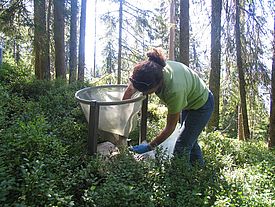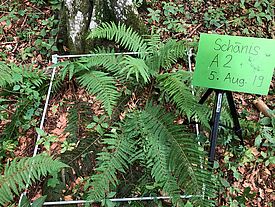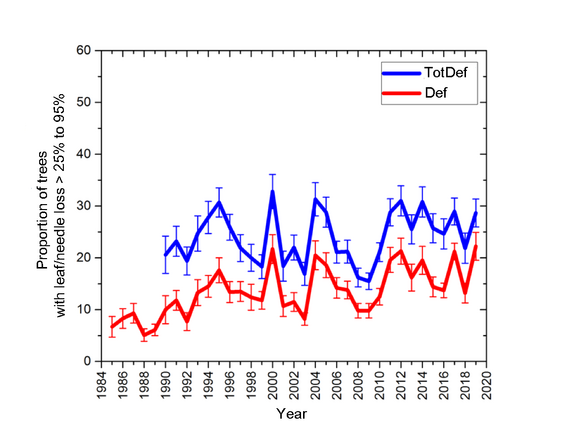Our forests differ not only in tree species, but also in the plants growing on the forest floor. Each forest site is characterized by typical vegetation. Climatic conditions and the local soil conditions are key factors.
Ground vegetation and tree stand respond to changes in both external environmental factors (e.g. climatic conditions or the atmospheric input of certain substances) and internal factors of the forest ecosystem (e.g. stand density). In order to investigate the influence of these changes, the LWF program periodically conducts harmonized surveys to record the species composition of the ground vegetation (34) and the condition of the tree stand.
Every five years, during the inventory (21), we record the height and diameter at breast height of the trees in order to determine the stock (standing volume) as well as the wood increment (change in volume). We use permanent tree-girth tapes (32) to assess annual changes in diameter. The growth pattern can also be determined retrospectively by analysing tree rings (33) in cores. High temporal resolution measurements of stem radius variations (28), sap flow (29) and stem CO2 concentrations (30) during the vegetation period provide further important information for estimating the influence of external factors.
Changes in the condition and mortality of the stand are documented with a standardised annual crown condition assessement (22), which is carried out both on the LWF sites and on the representative network of Sanasilva sites (16x16 km).
We determine the quantity of leaves or needles by indirect methods, for example by measuring the leaf leaf area index (24), or by recording leaf fall with litterfall collectors (25). The analysis of the nutrient content of freshly harvested leaves and needles (foliar analysis 23) or of the litter samples collected by the litterfall collectors (25) provide information on the nutritional status of the trees and the internal nutrient cycles. Annual recordings of visible ozone damage (26) provide data used to better estimate the ozone risk.
On permanent observation plots, we investigate the species composition and degree of coverage of the ground vegetation (34), especially in the shrub and herb layers. Further information on biodiversity is provided by the survey of lichens as well as by specimens collected in insect traps (35).



